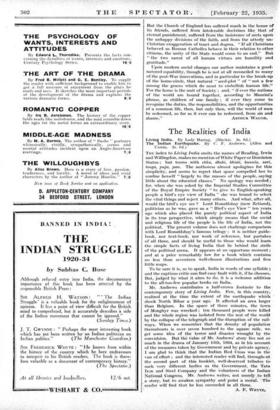The Realities of India
Living India. By Lady Hartog. (Blackie. 3s. 6d.)
THE index to Living India omits the names of Reading, Irwin and Willingdon, makes no mention of White Paper or Dominion Status ; but teems with ekka, dhobi, bhisti, bunnia, sari, tonga, puja, pan. The authoress almost apologizes for this simplicity, and seems to regret that space compelled her to confine herself "largely to the masses of the people, saying little about the educated classes." No apology was needed ; for, when she was asked by the Imperial Studies Committee of the Royal Empire Society "to give to English-speaking people a bird's eye view of India" she was bound to select the vital things and reject many others. And what, after all, would the bird's eye see ? Lord Ronaldshay (now Zetland), politician as he was, gave us a " Bird's eye View" ten years ago which also placed the purely political aspect of India in its true perspective, which simply means that the social and religious life of the people is the life of India, not the political. The present volume does not challenge comparison with Lord Ronaldshay's famous trilogy ; it is neither guide- book, nor text-book, 'Mr work of reference, but partakes of all three, and should be useful to those who would learn the simple facts of living India that lie behind the strife of the political arena. It appears at an 'opportune moment ; and at a price remarkably low for a book which contains no less than seventeen well-chosen illustrations and five little maps.
To be sure it is, so to speak, India in words of one syllable ; and the captious critic can find easy fault with it, if he chooses. But, judged by what it aims to do, it is a welcome addition to the all-too-few popular books on India.
Mr. Andrews contributes a _half-crown footnote to the contemporary story of Living India. Few, in this country, realized at the time the extent of the earthquake which - shook North Bihar a year. agog' It affected an area larger than Belgium. In the space of three minutes, the town of Monghyr was wrecked ; ten thousand people were killed and the whole region was isolated from the rest of the world by the collapse of the telegraph and the disruption Of the rail- ways. When we remember that the density of population' thereabouts is over, seven hundred to the square mile, we get some idea Of the terror and disaster wrought' by the convulsion. But the value Of Mr. Andrews' story lies not so much in the drama of January 15th, 1934, as in his account of the "measures taken by Government and by private agency. *I an glad to think that the Indian Red Cross was in the van of 'effort; and the interested reader will find, through t ut • the second part of this -booklet, well-deserved tributes to such 'very different bodies as the Government, the Tata Iron and Steel Company and the volunteers of the Indian National Congress, Mr. Andrews writes-, not merely to tell a story, but to awaken syMpathy and-point a moral. The reader will find that he has succeeded in all three.
A. F. Wlivrn.


















































 Previous page
Previous page